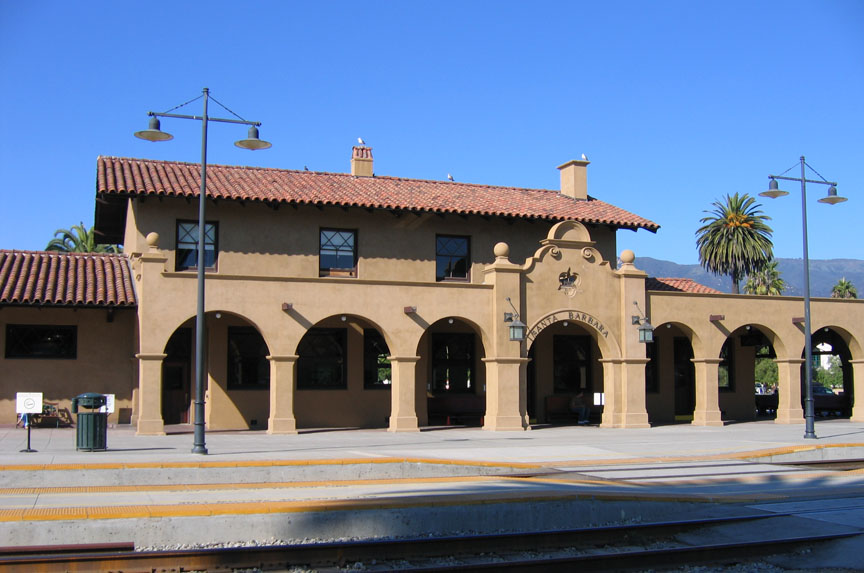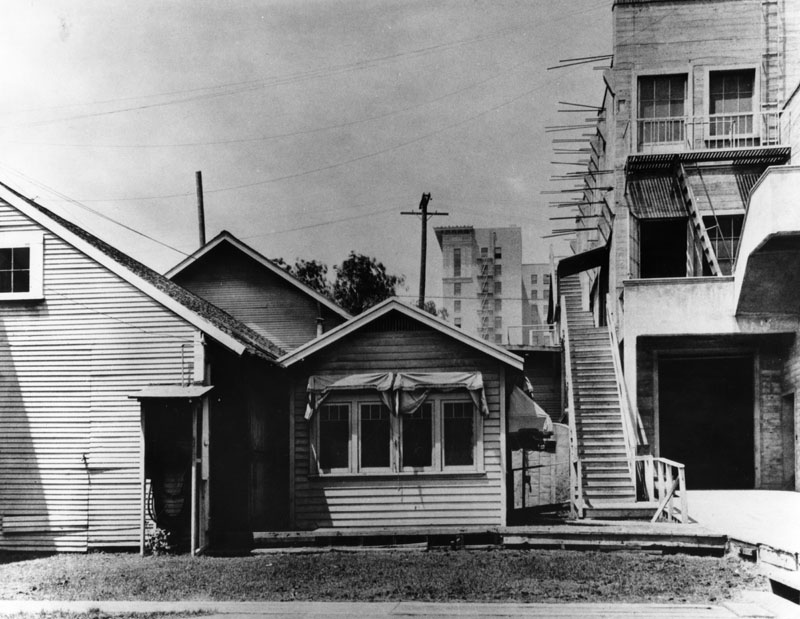|
Wattles Mansion
The Wattles Mansion, formally known as Jualita, is a former estate in the Hollywood area of Los Angeles, California. The mansion is a Mission Revival style mansion built in the estate in 1907 for wealthy Omaha banker Gurdon Wattles as his winter home; the estate contains a complex of gardens. It was sold to the city in 1968 and became the Wattles Garden Park, operated by the Department of Recreation and Parks. The mansion and gardens were designated a Los Angeles Historic-Cultural Monument in 1993. The estate has been recognized as "the only remaining intact example of the once plentiful Hollywood estates from the period preceding the film industry, when Hollywood was primarily agricultural and was a wintering home for wealthy Easterners and Midwesterners." According to the City of Los Angeles, "'Jaulita' is one of the few remaining landscapes reminiscent of another era and tradition, possessing a genuine integrity of setting, design, workmanship, and association." [...More Info...] [...Related Items...] OR: [Wikipedia] [Google] [Baidu] [Amazon] |
Mission Revival Style Architecture
The Mission Revival style was part of an architectural movement, beginning in the late 19th century, for the revival and reinterpretation of American colonial styles. Mission Revival drew inspiration from the late 18th and early 19th century Spanish missions in California. It is sometimes termed California Mission Revival, particularly when used elsewhere, such as in New Mexico and Texas which have their own unique regional architectural styles. In Australia, the style is known as Spanish Mission. The Mission Revival movement was most popular between 1890 and 1915, in numerous residential, commercial and institutional structures, particularly schools and railroad depots. Influences All of the 21 Franciscan Alta California missions (established 1769–1823), including their chapels and support structures, shared certain design characteristics. These commonalities arose because the Franciscan missionaries all came from the same places of previous service in Spain and colo ... [...More Info...] [...Related Items...] OR: [Wikipedia] [Google] [Baidu] [Amazon] |
Lawn
A lawn () is an area of soil-covered land planted with Poaceae, grasses and other durable plants such as clover lawn, clover which are maintained at a short height with a lawn mower (or sometimes grazing animals) and used for aesthetic and recreational purposes—it is also commonly referred to as part of a garden. Lawns are usually composed only of grass species, subject to weed control, weed and pest control, maintained in a green color (e.g., by Irrigation, watering), and are regularly mowed to ensure an acceptable length. Lawns are used around houses, apartments, commercial buildings and offices. Many city parks also have large lawn areas. In recreational contexts, the specialised names Sod, turf, parade, pitch, field or green may be used, depending on the sport and the continent. The term "lawn", referring to a managed grass space, dates to at least the 16th century. With suburban expansion, the lawn has become culturally ingrained in some areas of the world as part o ... [...More Info...] [...Related Items...] OR: [Wikipedia] [Google] [Baidu] [Amazon] |
Hollywood Heritage
The Hollywood Heritage Museum, also known as the "Hollywood Studio Museum," is located on Highland Ave. in Hollywood, California, United States. The museum is opposite the Hollywood Bowl and is housed in the restored Lasky-DeMille Barn, which was acquired in February 1983 by Hollywood Heritage, Inc., and moved to its present site. It was dedicated on December 13, 1985. Hollywood Heritage was founded in 1980 to address the preservation, restoration and maintenance of early Hollywood treasures. The first major success was acquiring, moving, and restoring the Lasky-DeMille Barn, opening it in 1985 as its museum. The museum features archival photographs from the silent era of motion pictures, movie props, historic documents and other movie related memorabilia. Also featured are historic photographs and postcards of the streets, buildings and residences of Hollywood during its golden age. Special events entitled 'Evenings at the Barn' are open to the public and regularly programmed i ... [...More Info...] [...Related Items...] OR: [Wikipedia] [Google] [Baidu] [Amazon] |
Santa Monica Mountains National Recreation Area
The Santa Monica Mountains National Recreation Area (SMMNRA) is a national recreation area containing many individual parks and open space preserves, located primarily in Southern California's Santa Monica Mountains. Located in greater Los Angeles, two thirds of SMMNRA's parklands are in northwest Los Angeles County and the remaining third, including a Simi Hills extension, is in southeastern Ventura County. It is administered by the National Park Service in coordination with state, county, municipal, and university agencies. In size, the Santa Monica Mountains National Recreation Area is the largest urban national park in the world. It is also one of the best examples of a Mediterranean climate ecosystem and it protects one of the highest densities of archaeological resources in any mountain range in the world.National Park Service, ''Santa Monica Mountains National Recreation Area: Statement of National Significance'', ca. 2000, page 4 Geography The Santa Monica Mountains NR ... [...More Info...] [...Related Items...] OR: [Wikipedia] [Google] [Baidu] [Amazon] |
Runyon Canyon Park
Runyon Canyon Park is a park in Los Angeles, California, at the eastern end of the Santa Monica Mountains, managed by the Los Angeles Department of Recreation and Parks. The southern entrance to the park is located at the north end of Fuller Avenue in Hollywood, Los Angeles, California, Hollywood. The northern entrance is off the 7300 block of Mulholland Drive. The Runyon Canyon Road, a fire road that is closed to public motor vehicle access, runs roughly through the center of the park between the northern and southern entrances along Runyon Canyon itself, and there are numerous smaller hiking trails throughout the park. The highest point in the park at an elevation of 1,320 ft (402 m) is known as Indian Rock. Because of its proximity to residential areas of Hollywood and the Hollywood Hills, celebrity sightings are common.Brownfield, Pau'Hancock's' Jason Bateman enjoys the Hollywood climbLos Angeles Times. July 4, 2008 "Nestled in the hills to the west of the Hollywood sign ... [...More Info...] [...Related Items...] OR: [Wikipedia] [Google] [Baidu] [Amazon] |
Santa Monica Mountains Conservancy
The Santa Monica Mountains Conservancy is an agency of the state of California in the United States founded in 1980 and dedicated to the acquisition of land for preservation as open space, for wildlife and California native plants habitat Nature Preserves, and for public recreation activities. The Santa Monica Mountains Conservancy was established by the California State Legislature in 1980. Since that time, it has helped to preserve over 72,000 acres of parkland in both wilderness and urban settings, and improved more than 114 public recreational facilities throughout Southern California. Additionally, it has given grants to nonprofit organizations for educational and interpretation programs that have served hundreds of thousands of children and other park visitors. Territory protected The Santa Monica Mountains Conservancy territory originally was within the Santa Susana Mountains and Santa Monica Mountains, and the Simi Hills; areas located north and west of metropolita ... [...More Info...] [...Related Items...] OR: [Wikipedia] [Google] [Baidu] [Amazon] |
California Coastal Sage And Chaparral
The California coastal sage and chaparral () is a Mediterranean forests, woodlands, and scrub ecoregion, defined by the World Wildlife Fund, located in southwestern California (United States) and northwestern Baja California (Mexico). It is part of the larger California chaparral and woodlands ecoregion. The ecoregion corresponds to the USDA Southern California ecoregion section 261B, and to the EPA Southern California/Northern Baja Coast ecoregion 8. Geography The California coastal sage and chaparral ecoregion covers about of coastal terraces, plains, and foothills between Santa Barbara, California and northeastern Baja California. This includes the southwestern slopes of the Transverse and Peninsular Ranges, the entirety of the Santa Susana and Santa Monica Mountains, the Channel Islands, Guadalupe Island, and Cedros Island. Major urban centers located within this ecoregion include Greater Los Angeles, San Diego-Tijuana, Ensenada, and Tecate. Climate The climate is Mediter ... [...More Info...] [...Related Items...] OR: [Wikipedia] [Google] [Baidu] [Amazon] |
Coastal Sage Scrub
Coastal sage scrub, also known as coastal scrub, CSS, or soft chaparral, is a low scrubland plant community of the California coastal sage and chaparral subecoregion, found in coastal California and northwestern coastal Baja California. It is within the California chaparral and woodlands ecoregion, of the Mediterranean forests, woodlands, and scrub biome. Characteristics ;Plant community Coastal sage scrub is characterized by low-growing aromatic, and drought-deciduous shrubs adapted to the semi-arid Mediterranean climate of the coastal lowlands. The community is sometimes called "soft chaparral" due to the predominance of soft, drought-deciduous leaves in contrast to the hard, waxy-cuticled leaves on sclerophyllous plants of California's chaparral communities. ;Flora Characteristic shrubs and subshrubs include: * California sagebrush (''Artemisia californica'') * Black sage (''Salvia mellifera'') * White sage (''Salvia apiana'') * California buckwheat (''Eriogonum fasci ... [...More Info...] [...Related Items...] OR: [Wikipedia] [Google] [Baidu] [Amazon] |
Japanese Garden
are traditional gardens whose designs are accompanied by Japanese aesthetics and philosophical ideas, avoid artificial ornamentation, and highlight the natural landscape. Plants and worn, aged materials are generally used by Japanese garden designers to suggest a natural landscape, and to express the fragility of existence as well as time's unstoppable advance. Ancient Japanese art inspired past garden designers. Water is an important feature of many gardens, as are rocks and often gravel. Despite there being many attractive Japanese flowering plants, herbaceous flowers generally play much less of a role in Japanese gardens than in the West, though seasonally flowering shrubs and trees are important, all the more dramatic because of the contrast with the usual predominant green. Evergreen plants are "the bones of the garden" in Japan. Though a natural-seeming appearance is the aim, Japanese gardeners often shape their plants, including trees, with great rigour. Japanese literatur ... [...More Info...] [...Related Items...] OR: [Wikipedia] [Google] [Baidu] [Amazon] |
Rose Garden
A rose garden or rosarium is a garden or park, often open to the public, used to present and grow various types of garden roses, and sometimes rose species. Designs vary tremendously and roses may be displayed alongside other plants or grouped by individual variety, colour or class in rose beds. Technically it is a specialized type of shrub garden, but normally treated as a type of flower garden, if only because its origins in Europe go back to at least the Middle Ages in Europe, when roses were effectively the largest and most popular flowers, already existing in numerous garden cultivars. Origins of the rose garden Of the over 150 species of rose, the Chinese ''Rosa chinensis'' has contributed most to today's garden roses; it has been bred into garden varieties for about 1,000 years in China, and over 200 in Europe. It is believed that roses were grown in many of the early civilisations in temperate latitudes from at least 5000 years ago. They are known to have been grown ... [...More Info...] [...Related Items...] OR: [Wikipedia] [Google] [Baidu] [Amazon] |








